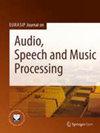Direction-of-arrival and power spectral density estimation using a single directional microphone and group-sparse optimization
IF 1.9
3区 计算机科学
引用次数: 0
Abstract
Abstract In this paper, two approaches are proposed for estimating the direction of arrival (DOA) and power spectral density (PSD) of stationary point sources by using a single, rotating, directional microphone. These approaches are based on a method previously presented by the authors, in which point source DOAs were estimated by using a broadband signal model and solving a group-sparse optimization problem, where the number of observations made by the rotating directional microphone can be lower than the number of candidate DOAs in an angular grid. The DOA estimation is followed by the estimation of the sources’ PSDs through the solution of an overdetermined least squares problem. The first approach proposed in this paper includes the use of an additional nonnegativity constraint on the residual noise term when solving the group-sparse optimization problem and is referred to as the Group Lasso Least Squares (GL-LS) approach. The second proposed approach, in addition to the new nonnegativity constraint, employs a narrowband signal model when building the linear system of equations used for formulating the group-sparse optimization problem, where the DOAs and PSDs can be jointly estimated by iterative, group-wise reweighting. This is referred to as the Group-Lasso with $$l_1$$基于单方向传声器和群稀疏优化的到达方向和功率谱密度估计
摘要本文提出了两种利用单旋转定向传声器估计静止点源的到达方向(DOA)和功率谱密度(PSD)的方法。这些方法基于作者先前提出的方法,其中通过使用宽带信号模型和解决组稀疏优化问题来估计点源doa,其中旋转定向麦克风的观测数量可以低于角网格中的候选doa数量。在DOA估计之后,通过求解过定最小二乘问题估计源的psd。本文提出的第一种方法包括在求解群稀疏优化问题时对残余噪声项使用附加的非负性约束,称为群Lasso最小二乘(GL-LS)方法。第二种提出的方法,除了新的非负性约束外,在构建用于制定群稀疏优化问题的线性方程组时采用窄带信号模型,其中doa和psd可以通过迭代,群加权来联合估计。这被称为Group-Lasso with $$l_1$$ 1 -reweighting (GL-L1)方法。这两种方法都使用乘法器的交替方向方法(ADMM)来实现,并通过考虑不同设置条件的仿真来评估它们的性能,这些条件包括不同类型的模型不匹配、声场景和麦克风指向性模式的变化。结果表明,在观测数据与所用信号模型麦克风响应不匹配的情况下,对残差噪声附加非负性约束可以改善GL-LS情况下的DOA估计和GL-L1情况下的PSD估计。此外,GL-L1方法在低信噪比或多个信源彼此靠近的情况下,在DOA估计性能方面比GL-LS方法具有优势。最后,研究表明,在大多数情况下,最小二乘PSD重估计步骤是有益的,因此GL-LS在PSD估计误差方面优于GL-L1。
本文章由计算机程序翻译,如有差异,请以英文原文为准。
求助全文
约1分钟内获得全文
求助全文
来源期刊

Journal on Audio Speech and Music Processing
Engineering-Electrical and Electronic Engineering
CiteScore
4.10
自引率
4.20%
发文量
28
期刊介绍:
The aim of “EURASIP Journal on Audio, Speech, and Music Processing” is to bring together researchers, scientists and engineers working on the theory and applications of the processing of various audio signals, with a specific focus on speech and music. EURASIP Journal on Audio, Speech, and Music Processing will be an interdisciplinary journal for the dissemination of all basic and applied aspects of speech communication and audio processes.
 求助内容:
求助内容: 应助结果提醒方式:
应助结果提醒方式:


